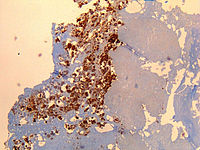
Photo from wikipedia
BackgroundPrior to the 2007–2010 Q fever epidemic in the Netherlands, the seroprevalence of antibodies against Coxiella burnetii in the general population was 1.5%, which is low compared to other countries.… Click to show full abstract
BackgroundPrior to the 2007–2010 Q fever epidemic in the Netherlands, the seroprevalence of antibodies against Coxiella burnetii in the general population was 1.5%, which is low compared to other countries. We aimed to determine the seroprevalence after the Q fever epidemic among people living in the affected area, compare the seroprevalence with the incidence of Q fever notifications during the 2007–2010 Q fever epidemic, and to identify farm exposures associated with having antibodies against C. burnetii.MethodsDuring the period March 2014–February 2015, residents aged 18–70 years from two provinces were invited by general practitioners to complete a questionnaire on their symptoms and personal characteristics and to submit a blood sample. We used the mandatory provincial database of livestock licences to calculate distance to farms/farm animals for each participant. To compare ELISA-positive participants for C. burnetii antibodies with those who were negative, we calculated prevalence ratios (PR) using binominal regression. We compared the C. burnetii seroprevalence in the period March 2014–February 2015 with the incidence of Q fever notifications during the 2007–2010 Q fever epidemic at municipal level by calculating the Spearman correlation coefficient.ResultsOf the 2296 participants (response rate: 34%), 6.1% (n = 139, 95% CI 5.1–7.1%) had C. burnetii antibodies (range in municipalities: 1.7–14.1%). C. burnetii seroprevalence was higher in individuals living within 1000 m of goat farms (PR 3.0; 95% CI 1.4–6.4) or within 1000 m of > 50 goats (PR 1.9; 95% CI 1.2–3.0). Seroprevalence increased with decreasing distance to the closest goat farm that was infected during the epidemic years (< 500 m, PR 9.5, 95% CI 2.8–32; 500–1000 m, PR 4.5, 95% CI 2.6–7.7; 1000–1500 m, PR 2.2, 95% CI 1.1–4.3, 1500–2000 m, PR 1.2, 95% CI 0.6–2.5; > 2000 reference group). There was no significant correlation between C. burnetii seroprevalence and Q fever incidence during the 2007–2010 epidemic (rs = 0.42, p = 0.156).ConclusionsResults showed a remarkable spatial variation in C. burnetii seroprevalence in a relatively small livestock dense area. It confirms previous evidence that the Q fever epidemic was primarily the result of airborne C. burnetii transmission from Q fever affected goat farms.
Journal Title: BMC Infectious Diseases
Year Published: 2017
Link to full text (if available)
Share on Social Media: Sign Up to like & get
recommendations!